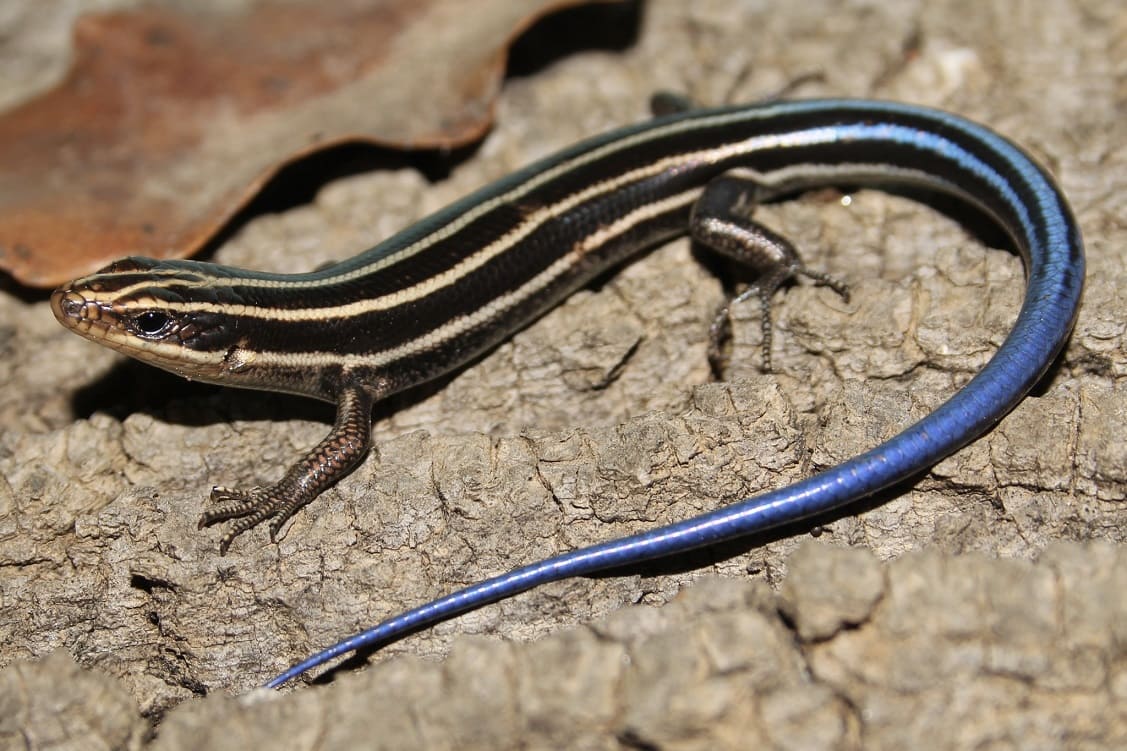Picture this: you’re enjoying your morning coffee on the patio when you spot a flash of metallic blue disappearing under a rock pile. That glimpse of electric color belonged to one of nature’s most efficient pest controllers—a skink.
These sleek, snake-like lizards might be small, but they’re working overtime to keep your garden free from the insects that would otherwise turn your prized tomatoes into Swiss cheese.
I discovered the true value of skinks three summers ago when my herb garden was under siege by an army of grasshoppers. Despite my best organic efforts, these voracious pests were decimating my basil and devouring my oregano. Then, almost overnight, the grasshopper problem mysteriously vanished.
The secret? A family of five-lined skinks had quietly moved into the rock border I’d built around my herbs, and they were methodically hunting down every last grasshopper with the precision of tiny, scaled ninjas.
That experience transformed me from a casual observer into a dedicated skink advocate. If you’ve ever wondered about those quick-moving lizards darting through your garden, or if you’re looking for a natural, sustainable way to manage garden pests, you’re about to discover why skinks deserve a permanent place in your backyard ecosystem.
Related post: Attract Hedgehogs to Your Garden with These Simple Tips
What Are Skinks, and Why Should You Care?
Skinks belong to the family Scincidae, one of the most diverse lizard families in the world with over 1,500 species. These remarkable reptiles are distinguished by their smooth, overlapping scales that give them an almost snake-like appearance, though their small legs and ability to blink quickly identify them as lizards.
In North America, you’re most likely to encounter species like the American Five-lined Skink (Plestiodon fasciatus) or various garden skinks, depending on your region. What makes these creatures truly special isn’t just their sleek appearance—it’s their incredible appetite for the very pests that plague gardeners everywhere.
The Skink Advantage: Nature’s Pest Control Squad
During my years of watching skinks in action, I’ve been consistently amazed by their hunting prowess. A single skink can consume dozens of insects daily, including:
- Crickets and grasshoppers that munch on your vegetables
- Beetles that attack your flowers
- Spiders (including those you’d rather not meet)
- Cockroaches seeking shelter in your home
- Caterpillars before they become crop-damaging moths
- Slugs and snails that leave slime trails on your lettuce
- Earwigs hiding in your garden mulch
Unlike chemical pesticides that can harm beneficial insects and pollinators, skinks are precision hunters. They target genuine pests while leaving helpful insects like bees and butterflies alone. It’s like having a team of selective, eco-friendly exterminators working around the clock in your garden.
Meet Your Local Skink Species
Five-Lined Skinks: The Striped Speedsters
The American Five-lined Skink (Plestiodon fasciatus) is probably the most recognizable species across much of the eastern United States, ranging from southern Canada to northern Florida. Adults typically measure 5-8.5 inches total length and can live up to 6 years in the wild.
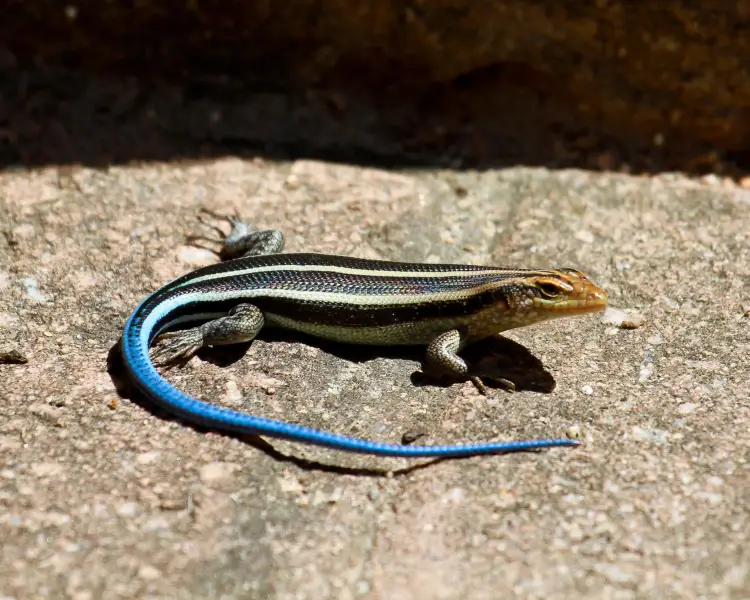
Identification Features:
- Juveniles: Jet black with five bright yellow stripes and electric blue tails
- Adult females: Retain stripes and some blue tail coloring
- Adult males: Develop bronze coloration with orange-red heads during breeding season
- Key feature: Four scales between the eye and nostril (vs. five in Broad-headed Skinks)
I remember the first time I witnessed a juvenile’s blue tail in action. A neighborhood cat had cornered what I thought was a doomed young skink near my compost pile. Suddenly, the skink’s tail detached and continued writhing on the ground while the skink itself vanished into the leaf litter.
The cat spent several confused minutes batting at the still-moving tail before losing interest. Three months later, I spotted what I’m convince was the same skink—now sporting a shorter, darker regenerated tail but very much alive.
Garden Skinks: The Backyard Regulars
Garden skinks (various Lampropholis and Scincella species) are the workhorses of suburban pest control. These smaller lizards—typically 3-5 inches long with 2-3 year lifespans—may not have flashy coloration, but they compensate with remarkable numbers and pest-eating efficiency.
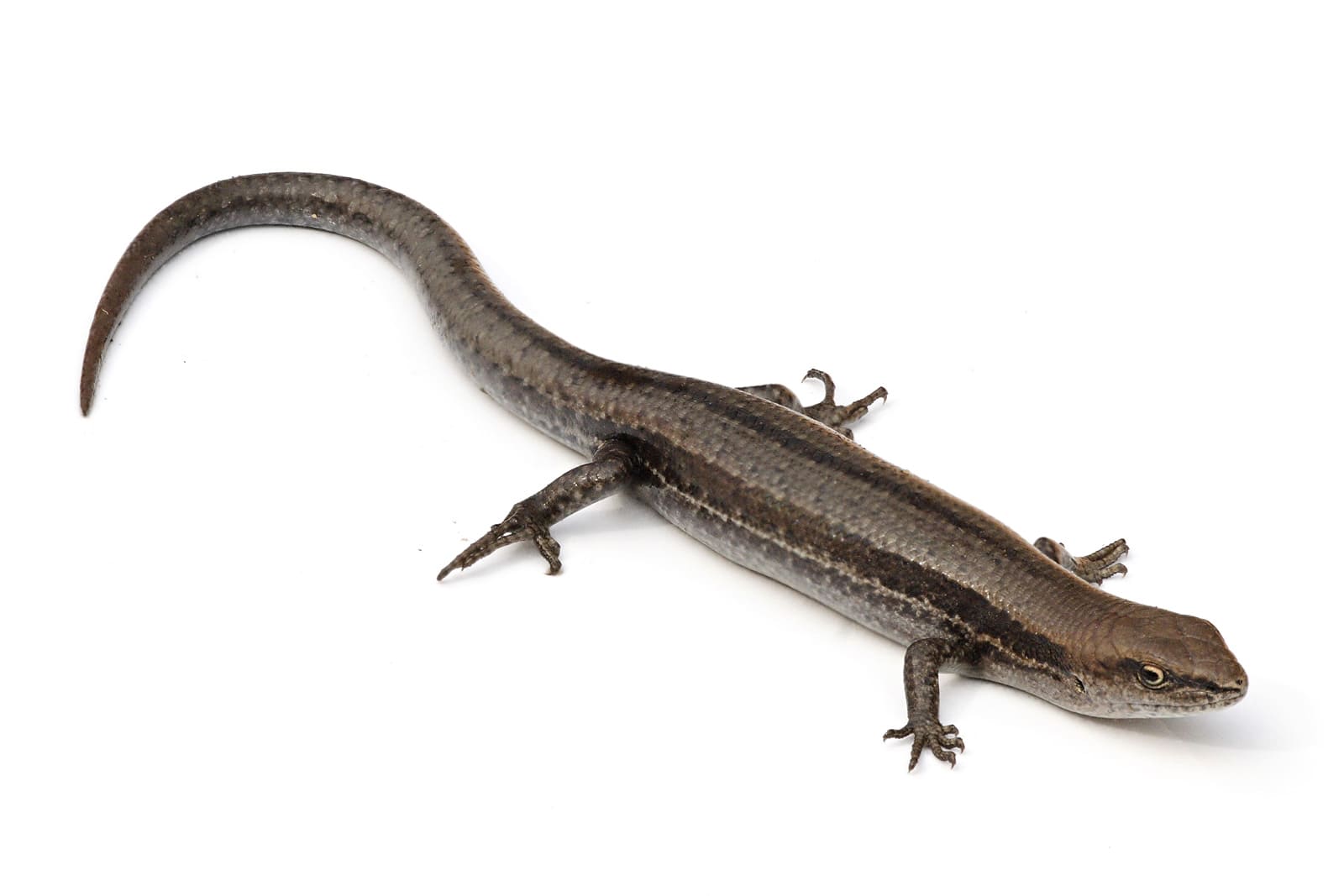
Common Species Include:
- Common Garden Skink (Lampropholis guichenoti): Brown to bronze with dark side stripes
- Little Brown/Ground Skink (Scincella lateralis): North America’s smallest lizard at just 3-5.75 inches
- Delicate Garden Skink (Lampropholis delicata): Introduced species in some regions
Understanding Native vs. Introduced Species
While most North American skinks are beneficial natives, some regions have introduced species that may compete with local wildlife.
The Delicate Garden Skink (Lampropholis delicata), for example, has established populations in Hawaii and parts of the Pacific. Understanding which species belong in your area helps you make informed habitat decisions.
Research Local Species: Before creating habitat, identify which skinks are native to your region. Your local extension office, wildlife agency, or native plant society can provide species lists and identification guides.
Amazing Skink Adaptations: Built for Garden Success
The Tail Drop Defense System
Skink tail autotomy (self-amputation) is far more sophisticated than a simple break-away mechanism. Most skink tail vertebrae contain specialized fracture planes—predetermined weak spots that allow clean separation when muscles contract rapidly.
The detached tail continues moving for several minutes thanks to stored nerve impulses, creating a highly effective predator distraction.
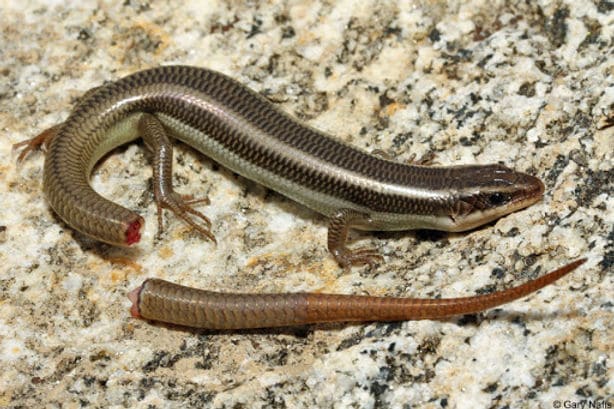
Regeneration Process: A new tail begins growing within weeks, though the replacement lacks the original’s bone structure and often appears shorter and differently colored. While regeneration requires significant energy, healthy skinks can repeat this defense multiple times throughout their lives.
Temperature Regulation Mastery
As ectothermic (cold-blooded) animals, skinks are master thermoregulators who actively manage their body temperature throughout the day:
- Morning Warm-up: Skinks emerge to bask on sun-warmed surfaces, raising their body temperature from cool overnight lows to active hunting levels (typically 80-85°F optimal range).
- Heat Avoidance: During peak afternoon heat, they retreat to cool hiding spots, preventing dangerous overheating.
- Seasonal Adaptation: In colder climates, skinks enter brumation (reptilian hibernation) in protected sites below the frost line, often gathering in small groups for added warmth.
Predators and Natural Challenges
Understanding what threatens skinks helps you design protective habitat and identify potential problems:
Primary Predators:
- Domestic cats: The most serious urban threat to skink populations
- Birds: Crows, hawks, shrikes, and even small songbirds like robins
- Snakes: Especially kingsnakes, which specialize in reptile prey
- Small mammals: Shrews, moles, opossums, skunks, and raccoons
- Other reptiles: Larger lizards occasionally prey on smaller skinks
Environmental Threats:
- Pesticide poisoning: Both direct exposure and contaminated prey
- Habitat destruction: Urban development and excessive landscaping
- Vehicle mortality: Skinks crossing roads or driveways
- Climate extremes: Unusual weather patterns disrupting hibernation or breeding
Disease Considerations: Like most reptiles, skinks can carry salmonella bacteria. While rarely problematic in outdoor settings, basic hygiene (hand-washing after any contact) prevents potential issues. Wild skinks may also carry parasites, though these rarely affect other garden wildlife.
The Secret Life of Skinks: Behaviors That Benefit Your Garden
Hunting Strategies That Work
Skinks employ two main hunting methods, both perfectly suited to garden pest control:
- Sit-and-Wait Ambush:
Skinks position themselves near likely insect highways—along fence lines, under plant edges, or near compost areas—and wait for prey to pass within striking distance. I’ve watched a patient skink spend twenty minutes motionless beside my rain gauge, tongue occasionally flicking to test the air, before lightning-fast lunging at an unsuspecting cricket.
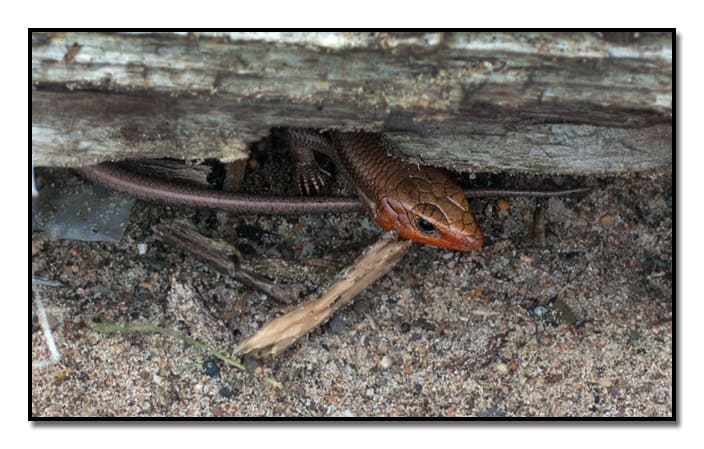
- Active Foraging:
When hunting actively, skinks methodically work through leaf litter, garden mulch, and plant bases, using their keen senses to locate hidden insects. This behavior is particularly valuable for controlling pests that hide during the day, like earwigs and small beetles.
Communication and Territory
Skinks are surprisingly social creatures with complex communication systems. Males perform head-bobbing displays and tail-flicking signals to establish territory, much like their larger lizard cousins.
During spring mating season, you might observe what looks like multiple skinks “wrestling”—this is actually territorial behavior that helps maintain optimal population densities in your garden.
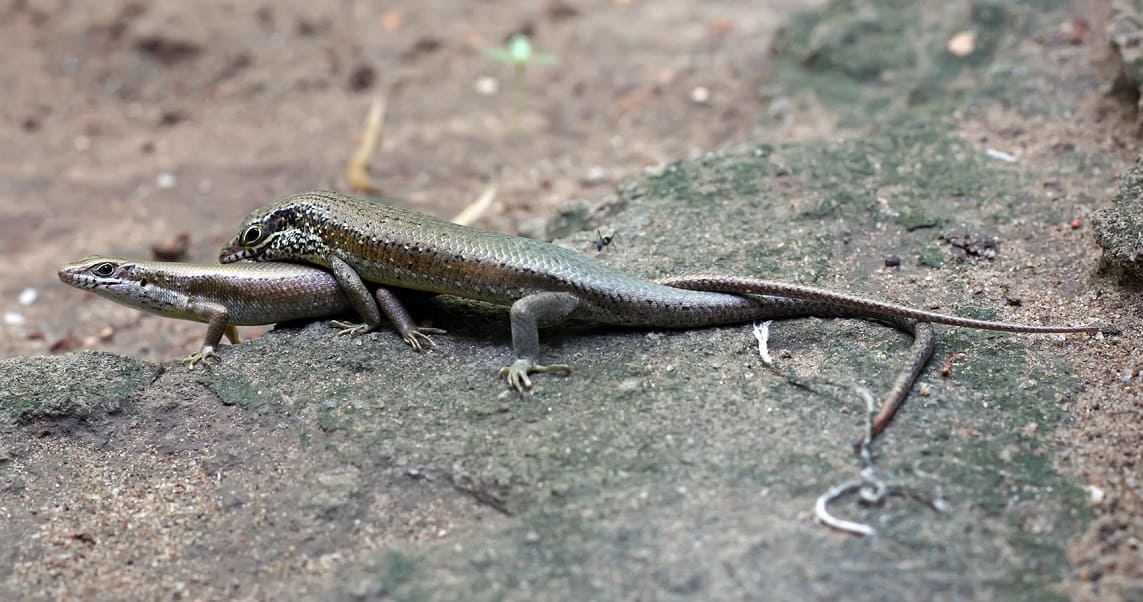
Maternal Investment: Protecting the Next Generation
Female skinks are devoted mothers who invest considerable energy in ensuring their offspring survive. After laying 4-18 eggs in carefully selected nest sites, females remain with their clutches for up to two months, turning eggs to maintain proper humidity, defending against small predators, and even eating rotten eggs to prevent disease.
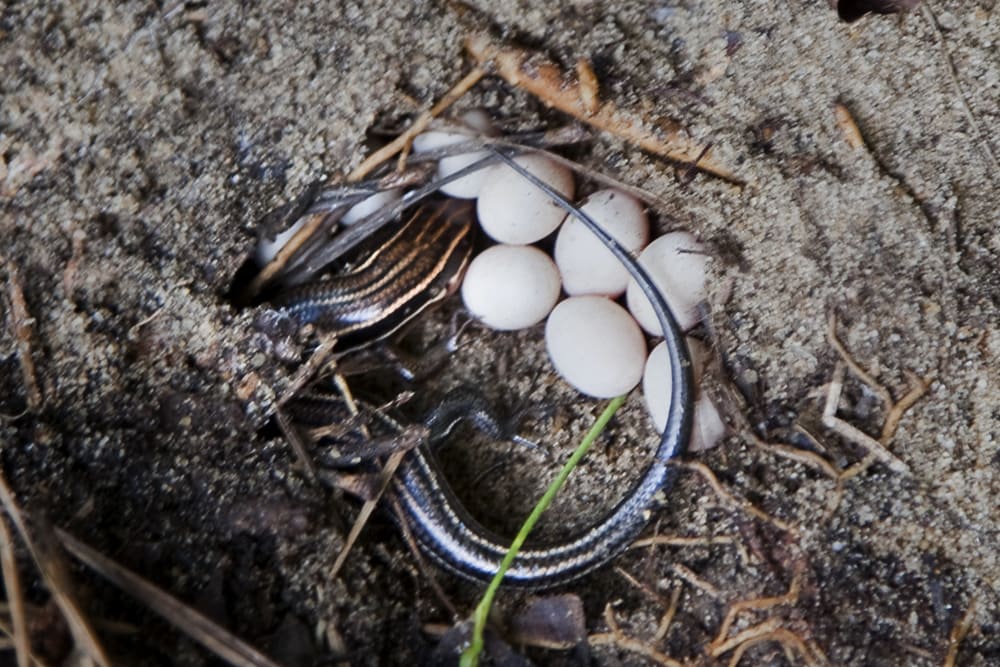
Last spring, I accidentally uncovered a skink nest while dividing perennials near my garden shed. Instead of fleeing, the mother skink coiled protectively around her eggs and hissed at me—a tiny dragon defending her treasure.
I carefully replaced the soil and marked the spot, checking back periodically. Six weeks later, tiny skinks emerged, each about the length of my pinky nail.
Creating Skink Paradise: Building the Perfect Habitat
Attracting skinks to your garden requires understanding their basic needs: shelter, basking spots, water, and food sources. The beauty of skink-friendly gardening is that these same features benefit many other beneficial wildlife species.
Essential Infrastructure
Rock Piles and Stone Walls:
Skinks need secure hiding spots within a tail’s length of open areas. Stack rocks loosely to create multiple crevices and hiding spots. Position these “skink condos” in areas that receive morning sun but have afternoon shade. I’ve found that mixing different rock sizes creates hiding spots suitable for both juvenile and adult skinks.
Advanced Habitat Projects
1. DIY Skink Shelter Box:
For gardeners wanting to provide premium skink housing, consider building a simple shelter box using weather-resistant plywood:
- Create a two-chamber design with a main cavity (300mm x 200mm) and smaller inner chamber (250mm x 200mm)
- Use 50mm end pieces to create multiple entrance/exit options
- Position in partial shade and secure with stones to prevent wind damage
- Surround with leaf litter and native plantings for natural integration
2. Rock Wall Construction:
Purpose-built stone walls offer permanent habitat while serving as attractive garden features. Layer stones with deliberate gaps, ensuring multiple hiding spots at different levels. Face walls southeast for optimal morning sun exposure while providing afternoon shade retreat options.
Read The Complete Guide to Hedgerows: Wildlife Havens for Your Property
3. Leaf Litter Corridors:
Instead of raking every leaf, create “wild zones” with natural leaf litter. These areas serve as insect habitats and skink hunting grounds. I maintain a leaf litter path connecting my rock piles to my water features, essentially creating a “skink highway” through my garden.
Water Features for Small Reptiles
While skinks obtain much of their water from prey, providing clean water sources ensures they’ll stay in your garden during dry periods.
- Shallow Basins:
Use plant saucers filled with smooth stones and just enough water to create puddles between the rocks. This design allows skinks to drink safely while preventing drowning. Place these near shelter areas where skinks feel secure.
- Ground-Level Accessibility:
Unlike water features designed for birds, skink water sources should be at ground level with gentle slopes or “ramps” for easy access. I buried a large plant saucer flush with the ground near my main rock pile and surrounded it with flat stones—it’s become a popular skink gathering spot.
Here’s How to Build a Bee Watering Station With Tips and Ideas for a Bee-Friendly Yard
Plant Selection: Native Species That Support Skink Ecosystems
- Ground Cover Champions:
Dense, low-growing plants provide both insect habitat and skink cover. Native options like wild ginger, native violets, or local sedges create perfect hunting environments.
Explore Top 22 Evergreen Junipers for Ground Cover and Garden Protection
- Berry-Producing Shrubs:
While skinks are primarily insectivorous, larger species enjoy small fruits. Native berry bushes like elderberry, serviceberry, or local Coprosma species provide food while attracting the insects that skinks hunt.
- Insect-Attracting Flowers:
Plants that draw pest insects also draw beneficial predators. Native wildflowers, herbs allowed to flower, and plants with small clustered blooms create buffet tables for skinks.
Here’s How to Create a Pollinator-Friendly Garden: A Step-by-Step Guide
Avoiding Common Skink Habitat Mistakes
- Over-Maintenance: The biggest mistake well-meaning gardeners make is keeping things too tidy. Skinks need some “messiness”—areas with natural debris, varied plant heights, and organic matter.
- Pesticide Use: Chemical pest control eliminates skinks’ food sources and can poison these beneficial hunters. Even “organic” pesticides like slug bait can be deadly to skinks that eat poisoned prey.
- Cat-Friendly Design: If outdoor cats frequent your area, ensure skink habitat includes quick escape routes and dense overhead cover. Cats are among the most serious threats to garden skink populations.
Here’s How to Design a Garden That Your Cat Will Love With Essential Tips and Ideas
Seasonal Skink Calendar: What to Expect Throughout the Year
Spring Awakening (March-May)
As temperatures warm, skinks emerge from winter hibernation sites and begin establishing territories. This is peak mating season, when you’re most likely to observe territorial displays and courtship behavior. It’s also the perfect time to prepare or improve skink habitat before the breeding season intensifies.
Garden Tasks: Clean and refresh rock piles, add new logs or stones, ensure water sources are clean and accessible.
Summer Activity Peak (June-August)
Summer brings maximum skink activity as adults hunt actively to support growing families. Eggs are typically laid in June and July, with females dedicating significant energy to nest protection. This is when skinks provide maximum pest control benefits.
Garden Tasks: Maintain water sources during dry periods, avoid disturbing potential nest sites, observe and enjoy peak skink activity.
Autumn Preparation (September-November)
Young skinks hatch and begin independent hunting while adults prepare for winter by building fat reserves. Skinks often venture into new areas during this period as juveniles disperse from natal territories.
Garden Tasks: Leave autumn leaves in wildlife areas, ensure winter shelter sites are available, plant native berries for next year’s ecosystem support.
Winter Dormancy (December-February)
In colder climates, skinks enter brumation (reptilian hibernation) in protected sites below the frost line. In warmer regions, they remain active but less visible during cool weather.
Garden Tasks: Protect known hibernation sites from disturbance, plan habitat improvements for spring implementation.
Skink Species Spotlight: Regional Variations
Eastern United States: Five-Lined Dominance
The American Five-lined Skink reigns supreme across much of the eastern U.S., from southern Canada to northern Florida. These adaptable lizards thrive in both woodland edges and suburban gardens, making them ideal garden partners for most eastern gardeners.
- Habitat Preferences: Moist, partially wooded areas with abundant cover and basking sites. They’re particularly fond of old buildings, rock walls, and brush piles near deciduous forests.
- Pest Control Specialties: Excellent at controlling crickets, grasshoppers, and caterpillars. Adults can handle larger prey than smaller skink species.
Southeastern Variations: Multiple Species Benefits
The southeastern United States hosts multiple skink species, including the Southeastern Five-lined Skink and Broad-headed Skink. This diversity provides comprehensive pest control across different garden niches.
Broad-headed Skinks: These larger cousins excel at controlling bigger pests and can handle small rodents in addition to insects. Males develop impressive orange-red heads during breeding season.
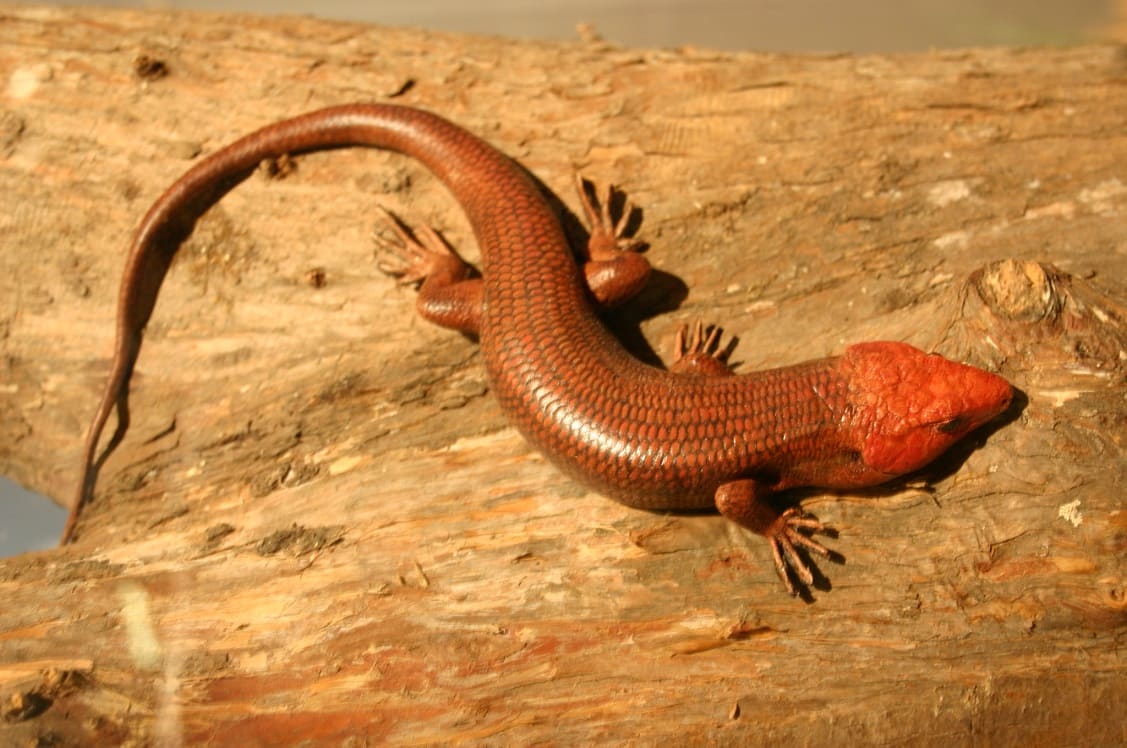
Ground Skinks: Tiny but efficient, these specialists work the leaf litter layer, controlling small insects and spiders that larger species might miss.
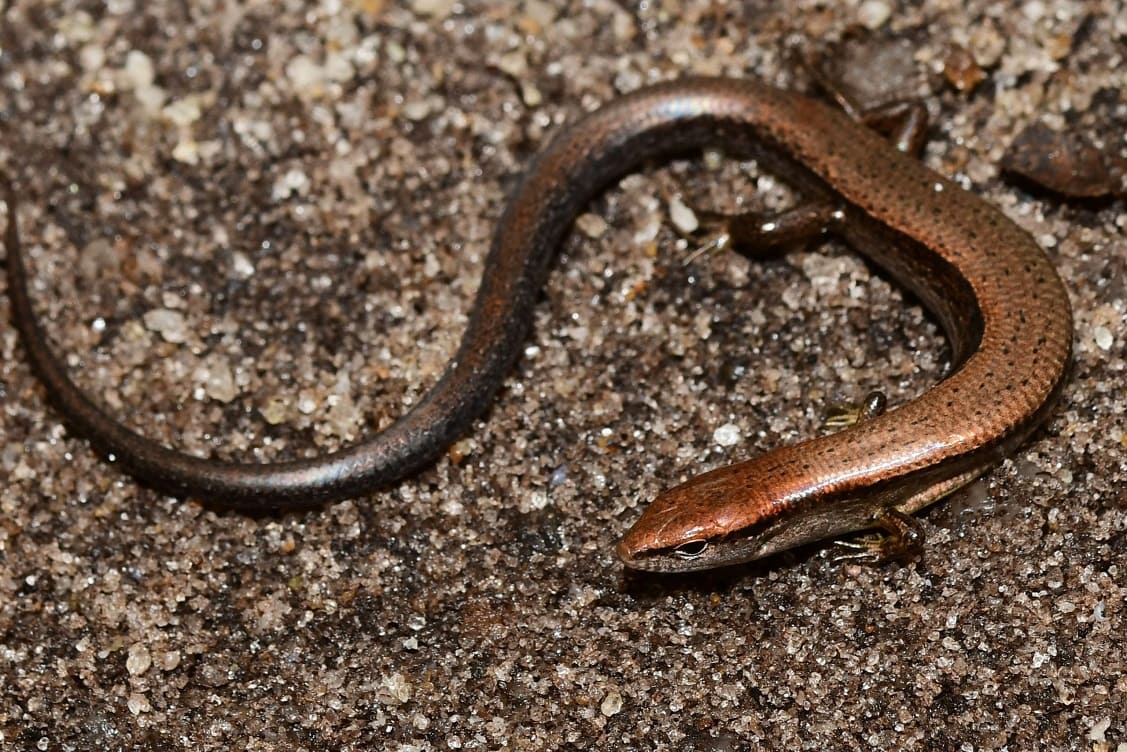
Western Adaptations: Dry Climate Champions
Western skink species have adapted to more arid conditions while maintaining their pest control effectiveness. Species like the Western Skink (Plestiodon skiltonianus) thrive in rockier, drier habitats.

Garden Adaptations: Focus on rock gardens, xeriscaping, and drought-tolerant native plants that still provide insect habitat.
Coexisting with Skinks: Common Concerns and Solutions
“I Found Skinks in My House!”
House invasions typically occur when skinks follow insects indoors or seek shelter during extreme weather. While startling, indoor skinks are harmless and indicate that your outdoor habitat is working—perhaps too well!
- Gentle Removal: Use a soft-bristled brush and dustpan to capture house guests, or simply leave doors open in the evening when skinks naturally seek outdoor shelter.
- Prevention: Seal gaps around doors and windows, but remember that some entry points also prevent beneficial insects from entering.
Safety Concerns: Children and Pets
Skinks are completely harmless to humans. While they may bite if handled roughly, their small teeth can barely break human skin. However, they can carry salmonella like most reptiles, so hand-washing after any contact is wise.
- Pet Interactions: Dogs typically ignore skinks, but cats instinctively hunt them. If you have outdoor cats, consider creating elevated skink habitat that cats cannot access.
- Teaching Children: Skinks provide excellent opportunities to teach children about beneficial wildlife. The rule in my garden is “observe but don’t touch”—skinks are much more interesting when behaving naturally.
Here’s How to Create a Fun and Educational Vegetable Garden for Kids
Population Management
Successful skink habitat sometimes works too well, leading to higher populations than expected. This is rarely problematic since skinks self-regulate through territorial behavior, but understanding population dynamics helps set realistic expectations.
- Natural Balance: Healthy skink populations stabilize naturally as territory size limits breeding opportunities. More skinks simply means more pest control and more wildlife viewing opportunities.
- Integration Benefits: High skink populations often indicate thriving garden ecosystems that support birds, beneficial insects, and other desirable wildlife.
Advanced Skink Gardening: Pro Tips for Maximum Success
Microhabitat Engineering
Create varied microclimates within your skink habitat to support different species and life stages. Combine south-facing basking rocks with north-facing cool retreats, moist areas near water features with well-drained rocky zones.
- Temperature Gradients: Skinks are ectothermic and need options for temperature regulation throughout the day. Design habitat areas with both sunny and shaded options.
- Substrate Variety: Mix fine soil areas for egg-laying with coarser rocky areas for hunting and hiding. Different substrate types support different prey insects.
Integrated Pest Management with Skinks
Use skinks as the foundation of a comprehensive natural pest control strategy:
- Complementary Predators: Skinks control ground-dwelling and hiding pests while birds handle flying insects and beneficial insects manage aphids and other soft-bodied pests.
- Habitat Overlap: Design garden areas that support multiple beneficial species—rock piles that shelter skinks can also provide nesting sites for beneficial wasps and spiders.
- Monitoring Success: Track pest problems in areas with and without skink habitat to document their effectiveness. I’ve found that areas within 50 feet of established skink habitat have noticeably fewer pest issues.
Community Skink Projects
Consider organizing neighborhood skink habitat projects to create wildlife corridors that support larger, more stable populations:
- Connecting Habitats: Work with neighbors to create connected wildlife corridors that allow skinks to move between properties safely.
- Education Opportunities: Share successful skink gardening techniques with fellow gardeners. Many people appreciate beneficial wildlife once they understand the pest control benefits.
- Citizen Science: Participate in local wildlife monitoring programs that track reptile populations and habitat success.
Troubleshooting Common Skink Habitat Challenges
“I Built Habitat But No Skinks Appeared”
Skink colonization requires patience, especially in urban areas where populations may be distant or fragmented.
- Timeline Expectations: Established skink habitat may take 1-2 seasons to attract residents, particularly if local populations are small or separated by development.
- Connectivity Solutions: Skinks may be present nearby but unable to safely reach your habitat. Consider creating stepping-stone habitats or wildlife corridors connecting to natural areas.
- Regional Considerations: Some areas may lack skink populations due to intensive development, historical pesticide use, or habitat fragmentation. Focus on supporting whatever native reptiles are present locally, as habitat improvements benefit multiple species.
Seasonal Activity Concerns
New skink gardeners often worry when activity decreases during certain seasons or weather conditions.
- Weather Sensitivity: Skinks are much less active during cool, cloudy, or wet weather. This is normal behavior, not a sign of habitat failure.
- Life Cycle Variations: Activity patterns change during breeding season, egg incubation periods, and juvenile dispersal. Understanding these cycles prevents unnecessary concern.
- Winter Preparations: Decreased autumn activity often indicates successful preparation for winter dormancy rather than population decline.
Balancing Multiple Garden Goals
Skink-friendly gardening sometimes conflicts with other garden objectives:
- Aesthetic Concerns: “Wild” areas necessary for skinks can be designed attractively using native plants, artistic stone arrangements, and purposeful “messy” zones.
- Vegetable Gardening: Integrate skink habitat around vegetable gardens where pest control benefits are most needed. Rock borders and log paths can be both functional and attractive.
- Lawn Areas: Maintain skink corridors and habitat islands even in primarily lawn landscapes. Small wild zones can support surprising wildlife diversity.
FAQ: Your Most Common Skink Questions Answered
- Q: Are skinks dangerous to humans or pets?
A: Skinks are completely harmless to humans and beneficial to gardens. While they may bite if handled roughly, their small teeth rarely break skin. Like all reptiles, they can carry salmonella, so hand-washing after contact is recommended. Most pets ignore skinks, though cats instinctively hunt them.
- Q: How can I tell if skinks are actually controlling pests in my garden?
A: Monitor pest populations in areas with and without skink habitat. I’ve documented significantly fewer grasshopper, cricket, and beetle problems within 50 feet of established skink colonies. You may also notice birds and other predators hunting in your skink areas, indicating a healthy insect ecosystem.
- Q: What should I do if I find skink eggs while gardening?
A: Carefully replace any disturbed soil and mark the area to avoid future disturbance. Skink eggs are small, white, and leathery. If you must continue gardening in the area, gently relocate eggs to a similar protected spot nearby. Eggs typically hatch in 6-8 weeks during summer months.
- Q: How many skinks can my garden support?
A: Skink populations self-regulate through territorial behavior. A typical suburban garden might support 2-5 adult skinks depending on habitat quality and size. Higher numbers usually indicate excellent habitat and abundant food sources—exactly what you want for pest control.
- Q: Why did my skinks disappear suddenly?
A: Sudden skink disappearances usually stem from predator pressure (especially cats), pesticide use, major habitat disturbance, or seasonal movements during breeding or hibernation periods.
Extreme weather events can also temporarily displace populations. Address obvious threats and remain patient—skinks often return when conditions stabilize, though recolonization may take a full season.
Your Journey to Skink-Friendly Gardening
Creating a thriving skink habitat represents more than just pest control—it’s an investment in the complex, interconnected web of life that makes gardens truly sustainable.
When you provide shelter for skinks, you’re also supporting the insects they eat, the birds that occasionally prey on both, and the countless other creatures that make up a healthy garden ecosystem.
My own journey from casual observer to dedicated skink advocate has taught me that these small reptiles are remarkable indicators of garden health. A thriving skink population signals abundant insect life, diverse microhabitats, and minimal chemical interference—all hallmarks of a truly sustainable garden.
The best part? Once established, skink-friendly gardens largely maintain themselves. The rock piles continue providing shelter, the leaf litter areas keep supporting insects, and the skinks keep hunting pests year after year. It’s a beautiful example of working with nature rather than against it.
As you begin creating habitat for these beneficial hunters, remember that success often comes in small moments: the flash of a blue tail disappearing under your herbs, the satisfied feeling of knowing your pest control is entirely natural, or the joy of watching a young skink’s first successful hunt among your vegetables.
Start small—a single rock pile, a corner left wild, a shallow water dish among your plants. Observe what happens. Be patient. And prepare to be amazed by the efficient, elegant pest control team that’s been waiting all along for an invitation to call your garden home.
Your skinks are out there, ready to trade their natural pest control services for a safe place to call home. All you have to do is build it—and they will come.
